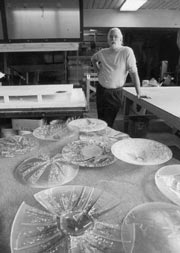GLASS ARTIST GEORGE Scott combed Seattle in the mid-’90s looking for a suitable living and work space until he found the ideal loft. Offering affordable rent and other artists as neighbors, the Bemis Building near Safeco Field became Scott’s home five years ago. The historic industrial building’s conversion for artists’ use was made possible by a Seattle initiative to allow artist studios and living spaces in industrial areas. (The city says it does not keep track of how many artists have been able to take advantage of this program.) Now Scott, who is being tossed out, claims his landlord is abusing this privilege by renting to anyone who can pay. His landlord says Scott is just a disgruntled tenant, but late last week the city claimed there are code violations at the Bemis. The city’s investigation may lead to changes in the code that governs who can legally live in Seattle’s industrial areas.
The virtues of Scott’s loft—with its hardwood floors, sturdy casings, high ceilings, and stunning views—are apparent. “When I moved in, it had the promise of being an artists’ community,” Scott says of the Bemis’ 30 artist studios and living spaces. Scott says all that has changed because of the “bottom line.” Last September, in a formal complaint to the city’s Department of Design, Construction, and Land Use (DCLU), Scott charged his landlord, David Huchthausen, was not playing by the rules. Doctors, high-tech workers, and former Seattle Sonic Sam Perkins are occupying spaces that should be going to artists, Scott claims.
Huchthausen has acquired “a permit that was intended to benefit working artists and maintain their presence in the city,” Scott wrote to the DCLU. “He has abused this privilege purely for the self-serving motive of profit by renting to the first person with cash.”
Huchthausen says that Scott is just “lashing out” following a decision last August not to renew the artist’s lease. “We’ve actually kicked people out who claimed to be artists but weren’t,” Huchthausen says. “We’ve taken great pains to ensure that everyone in here has a legitimate reason and need for the space.” Huchthausen says management has also made a concerted effort to keep rent affordable for artists—around $1 per square foot.
Huchthausen does acknowledge, however, that three units in the Bemis fall into a “gray area.” One of the spaces in question is a loft rented by basketball player Sam Perkins. Huchthausen says when he first leased to Perkins, the basketball player was doing some DJ work for local radio stations and needed a larger space to store his equipment and play music louder than in residential areas. Another “gray area,” Huchthausen says, is an architectural office. In both cases, the tenants have legitimate reasons for being in the building, Huchthausen claims, as they are arts-related.
LATE LAST WEEK, the DCLU found the building was in violation of its permit. “There are some violations there, we believe,” says Clay Thompson, who has been investigating the case for the DCLU. Thompson explains the violations revolve around “what constitutes an artist that would require a space of this nature—the code says the artist must demonstrate a need for this space.”
Huchthausen and Somerset Properties will be given a period of time to correct the infractions and get up to code, DCLU’s Thompson says. He explains it’s possible that some of the tenants who do not meet the city’s requirements would have to move. “In a lot of these situations, we try not to create a hardship,” Thompson continues. “We may allow them to stay longer than what was normally acceptable.”
Scott’s complaint has pointed out possible loopholes in the city’s land use code concerning artists who live in industrial areas. Back in the 1980s, the Seattle City Council wrote the code to facilitate artists’ occupation of industrial buildings that had outlived their usefulness. At first, only “industrial artists,” such as those who use welding or heavy machinery in their work, were permitted to live and work in the converted industrial buildings, according to DCLU’s John Skelton. The council later modified the code to allow occupation by any artist who demonstrates a legitimate need and purpose for such space, Skelton continues. This more general definition has created ambiguities in the policy, according to Skelton, and figuring out which artists fit the criteria is tough. Skelton says DCLU wants to make improvements to the existing policy. If the council or the mayor makes it a priority, DCLU will fine-tune the language, he adds.
Meanwhile, Scott will be out of the Bemis Building next month, and his search for a new loft has taken him to West Seattle and Tacoma. He is continuing his crusade to make sure artist housing is not simply given away to the highest bidder. His next stop is the City Council. If he doesn’t get results from the politicians, he may file a lawsuit. “I’m not a developer, I’m an artist,” Scott says. “Those are the people I speak for.”







